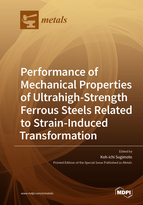Performance of Mechanical Properties of Ultrahigh-Strength Ferrous Steels Related to Strain-Induced Transformation
A special issue of Metals (ISSN 2075-4701). This special issue belongs to the section "Metal Casting, Forming and Heat Treatment".
Deadline for manuscript submissions: closed (30 September 2019) | Viewed by 38654
Special Issue Editor
Interests: steel; microstructure; mechanical property; micromechanics; heat treatment; thermo-mechanical process; metal forming; surface treatment
Special Issues, Collections and Topics in MDPI journals
Special Issue Information
Dear Colleagues,
This Special Issue of Metals is dedicated to advanced ultrahigh-strength ferrous steels related to the strain-induced martensite transformation (or transformation-induced plasticity) of metastable retained austenite. Ferrous steels, such as Transformation-Induced Plasticity (TRIP)-aided bainite/martensite steels, quenching and partitioning steels, nanostructured bainite steels, medium manganese steels, etc., are receiving a great deal of attention from both academic and industry sectors, due to their excellent mechanical properties. To apply ferrous steels to a wide range of components and parts, a detailed understanding of the performance of the mechanical properties, such as toughness, fatigue strength, delayed fracture strength, wear property, etc., after heat-treatment, thermo-mechanical process, plastic working (including hot-stamping, hot-forging), welding, surface treatment, etc., will be of great help to steel engineers in future.
For this Special Issue, we are inviting papers on the performance of the mechanical properties of advanced ultra-high-strength ferrous steels subjected to heat-treatment, plastic working, welding, surface treatment, etc. We also welcome novel research on conventional ultra-high-strength ferrous steels containing metastable retained or reverted austenite due to their current significant growth.
Prof. Koh-ichi Sugimoto
Guest Editor
Manuscript Submission Information
Manuscripts should be submitted online at www.mdpi.com by registering and logging in to this website. Once you are registered, click here to go to the submission form. Manuscripts can be submitted until the deadline. All submissions that pass pre-check are peer-reviewed. Accepted papers will be published continuously in the journal (as soon as accepted) and will be listed together on the special issue website. Research articles, review articles as well as short communications are invited. For planned papers, a title and short abstract (about 100 words) can be sent to the Editorial Office for announcement on this website.
Submitted manuscripts should not have been published previously, nor be under consideration for publication elsewhere (except conference proceedings papers). All manuscripts are thoroughly refereed through a single-blind peer-review process. A guide for authors and other relevant information for submission of manuscripts is available on the Instructions for Authors page. Metals is an international peer-reviewed open access monthly journal published by MDPI.
Please visit the Instructions for Authors page before submitting a manuscript. The Article Processing Charge (APC) for publication in this open access journal is 2600 CHF (Swiss Francs). Submitted papers should be well formatted and use good English. Authors may use MDPI's English editing service prior to publication or during author revisions.
Keywords
- Advanced ultrahigh-strength steels
- Strain-induced transformation
- Microstructure
- Mechanical property
- Heat treatment
- Thermomechanical process
- Stamping
- Forging
- Welding
- Surface treatment
- Applications






